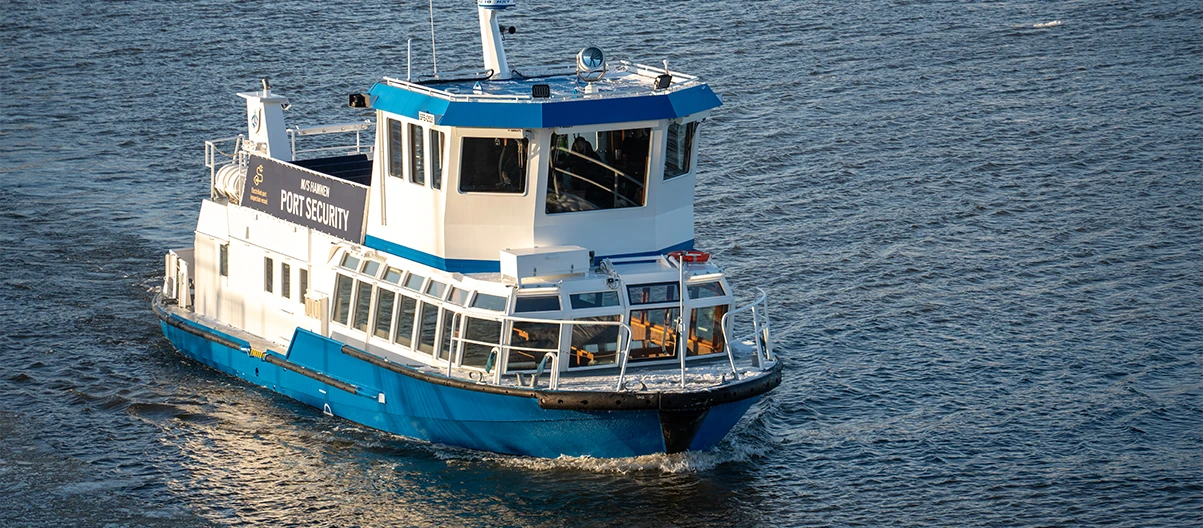
Port of Gothenburg’s Inspection Vessel Electrified
After serving around the clock as an inspection vessel at the Port of Gothenburg since 1979, it was time for M/S Hamnen to be converted to electric power. In addition to electrification, she underwent a renovation to extend her lifespan, aligning with the port's sustainability profile – preserving instead of purchasing new. This ensures the vessel can continue to serve the port authority for many more years.
Conversion Reduces Emissions More Than Replacement
Replacing M/S Hamnen was never an option. In 2019, the port began exploring the possibilities of converting the existing vessel to electric power. M/S Hamnen is in excellent condition, and no other boat is better suited for the task. By converting rather than replacing, emissions are further reduced as the vessel continues its service life. Over the years, M/S Hamnen has been in active operation for about 1,200 hours per year, consuming approximately 25,000 liters of diesel. This translates to about 67 tons of carbon dioxide emissions per year, which is around 15% of the total emissions directly from the port's operations.
M/S Hamnen - A Pioneer
For the Port of Gothenburg, the electrification of M/S Hamnen is not just a step towards achieving the port's climate goals but also about credibility. The Port of Gothenburg sets high standards for customers, partners, and stakeholders regarding climate transition, and leading by example is crucial. Converting and extending the life of a vessel the size of M/S Hamnen is uncommon, making the permitting process challenging, costly, and time-consuming. Despite this, the company is confident that vessels of this type are well-suited for electrification and represent future technology. By pioneering this development, the port can demonstrate that it is feasible, thereby making it easier for others to follow suit.
By showcasing this transformation, we aim to inspire and lead the way in sustainable maritime operations, proving that innovation and commitment can drive significant environmental progress.
Understanding the Electrification Process
In the engine room, a complete transformation was undertaken as M/S Hamnen's existing diesel engine was replaced with a brand new electric motor with a power output of 250 kW. Additionally, a battery bank weighing four to five tons and with a capacity of 520 kWh was installed, with the option to add more battery capacity in the future. In exceptional cases, such as special missions, unforeseen events, or extreme weather conditions, additional range may be required, and therefore, a diesel auxiliary engine powered by HVO is also installed. The vessel's mission is to be available in all circumstances 24/7, necessitating this flexibility.
The goal is to operate on battery power 90% of the time. M/S Hamnen's regular berth at Majnabbehamnen will be equipped with a 125-amp charger, sufficient for charging between regular missions. M/S Hamnen has been at Ö-varvet on Öckerö this year, and the work to convert the vessel to electric power has proceeded according to plan, despite the complexity of converting a 40-year-old vessel to electric power. Besides being environmentally beneficial, the electrification also improved the working environment for the crew onboard.
By transforming M/S Hamnen, we are not only taking a significant step towards sustainability but also setting a precedent for the future of maritime operations.
Facts About the inspection vessel
Previously, M/S Hamnen consumed 25,000 liters of diesel, resulting in 67 tons of carbon dioxide emissions, which accounted for 15% of the port authority's total emissions.
Length: 20.3 m
Width: 5.7 m
Draft: 2.6 m
Cruising Speed: 8 knots
Operating Hours per Year: 1200
New Electric Motor: 250 kW
Range: 6-7 hours at eco-speed
Investment: 19.8 million SEK
-67 Tons of CO2 Emissions
A reduction equivalent to 15% of the port authority's total emissions.
-67 Tons of CO2 Emissions
A reduction equivalent to 15% of the port authority's total emissions.
0%
A reduction equivalent to 15% of the port authority's total emissions.
0%
A reduction equivalent to 15% of the port authority's total emissions.